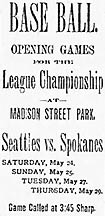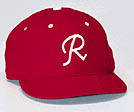

To understand why the major leagues coveted Seattle in the 1960s, you have to know a bit about the city's long and illustrious history as a baseball town.
The Seattle Alkis were the city's first organized team and self-proclaimed champions of the Pacific Coast. They were an amateur squad, active 1877-79, and when challenged, played games on a crude diamond at the Duwamish race track.
 A newspaper ad from 1890. |
Pro ball returned to stay in 1898, when former major league catcher Dan Dugdale—who's known as the father of Seattle baseball—founded a new team, the Braves. They played at Athletic Park, which was nicknamed "Band Box Park" because of its small size.
In 1903, the Pacific Coast League (P.C.L.) began operation and placed one of their charter franchises—the Siwashes—in Seattle. They played at Recreation Park, across from what would later become the Seattle Center. After a long, expensive battle which saw many players from both teams break their contract and jump leagues, Dugdale sold out to the Siwashes' owners.
Seattle dropped out of the P.C.L. in 1907, so Dugdale started a new team called the Giants, which
 The 1915 Seattle Giants pose on the infield at Dugdale Park. |
In 1919, the P.C.L. returned to Seattle. That team was known as the Rainiers until 1921, when the name was changed to the Indians. The Indians won Seattle's first P.C.L. championship in 1924.
When Dugdale Park burned down in 1932, the team moved to Civic Stadium (where Memorial Stadium now stands). It was a hard-pan field with chicken wire fences and enormous wooden light poles actually in play. The ballpark seemed to symbolize the lean years which were to come there.
In 1937, the Indians were sold to Emil Sick, owner of the Rainier Brewing Company. Sick changed the team's name to "Rainiers" and built Sick's Stadium. Between 1938 and 1943, the Rainiers made six straight playoff appearances, winning three pennants, 1939-1941.
 Rogers Hornsby's 1951 Rainiers finished 31 games over .500. |
After another playoff appearance in 1945, the Rainiers had a losing record until the 1951 team, managed by Hall of Famer Rogers Hornsby, brought home another pennant. In 1955, Rainiers general manager (and future Pilots owner) Dewey Soriano hired hometown hero, Fred Hutchinson as the team's new manager. Recapturing some of the magic of his rookie season, Hutchinson led the Rainiers to the pennant.
Between 1938 and 1957, the Rainiers led the P.C.L. in attendance nine times and outdrew San Francisco 14 times, but attendance started falling off when the Giants and Dodgers moved West.
 A Rainiers cap circa 1955. |
Rather than looking at the declining attendance as a warning sign, major league owners felt it showed that Seattle had outgrown minor league baseball. There were other factors which made Seattle desirable. It was the third-largest city in the West and was experiencing an economic boom, thanks largely to aerospace giant, Boeing. Another factor was geography. While the Giants and Dodgers had a natural rivalry in the National League, (prior to the Athletics' move to Oakland) the Angels' nearest competitor was in Kansas City. That kind of geographic spread meant high expenses and left a lot of the country without a major league team to call its own. The final factor was lack of competition from other professional sports. Seattle's only major league pro sports team was the National Basketball Association's Seattle SuperSonics—and that really didn't count because the N.B.A. in 1967 was not in the same class as baseball in terms of popularity.
It was with all this in mind that American League owners headed into their winter meetings in 1967. When the owners needed a second city to balance their expansion into Kansas City, Seattle got the nod.